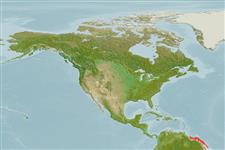Malacostraca |
Decapoda |
Palinuridae
Environment: milieu / climate zone / Mức độ sâu / distribution range
Sinh thái học
; Mức độ sâu 100 - 298 m (Tài liệu tham khảo 271). Tropical; 14°N - 1°N, 58°W - 47°W (Tài liệu tham khảo 4)
Western Atlantic.
Length at first maturity / Bộ gần gũi / Weight / Age
Chín muồi sinh dục: Lm ? range ? - ? cm Max length : 10.0 cm TL con đực/không giới tính; (Tài liệu tham khảo 271)
It has lengths of 10 cm, maximum body length; 1.6 to 3.2 cm, carapace length (Ref. 4). Occurs at depths from 120 and 298 m, but there is a record from the littoral zone, and one from 4111 to 4122 m. The bottom is variously described as "sand and coral, "sandy calcarenite", and "smooth, consisting of brown mud" (Ref. 4).
Life cycle and mating behavior
Chín muồi sinh dục | Sự tái sinh sản | Đẻ trứng | Eggs | Sự sinh sản | Larvae
Members of the order Decapoda are mostly gonochoric. Mating behavior: Precopulatory courtship ritual is common (through olfactory and tactile cues); usually indirect sperm transfer.
Holthuis, L.B. 1991 FAO Species Catalogue. Vol. 13. Marine lobsters of the world. An annotated and illustrated catalogue of species of interest to fisheries known to date. FAO Fish. Synop. 125(13):292p. Rome: FAO. (Tài liệu tham khảo 4)
IUCN Red List Status
(Tài liệu tham khảo 130435: Version 2025-1)
CITES status (Tài liệu tham khảo 108899)
Not Evaluated
CMS (Tài liệu tham khảo 116361)
Not Evaluated
Threat to humans
Human uses
Các nghề cá: không ích lợi (thú vị)
| FishSource |
Các công cụ
Thêm thông tin
Sinh thái dinh dưỡngFood items (preys)
Thành phần thức ăn
Thành phần thức ăn
Các động vật ăn mồi
Population dynamicsSự sinh trưởng
Max. ages / sizes
Length-weight rel.
Length-length rel.
Length-frequencies
Mass conversion
Sự phong phú
Life cycleSự tái sinh sảnChín muồi sinh dụcSự sinh sảnĐẻ trứngEggsEgg developmentLarvae PhysiologyThành phần ô-xy
Human RelatedStamps, coins, misc.
Các nguồn internet
Estimates based on models
Preferred temperature
(Ref.
115969): 13.6 - 18.8, mean 17.6 (based on 5 cells).
Fishing Vulnerability
Low vulnerability (10 of 100).
